15 Things to do at the Grand Canyon in April
April is arguably one of the best months of the year to visit the Grand Canyon! Visiting Grand Canyon National Park is great any time of year – just ask any of the 6 million visitors the site sees a year!
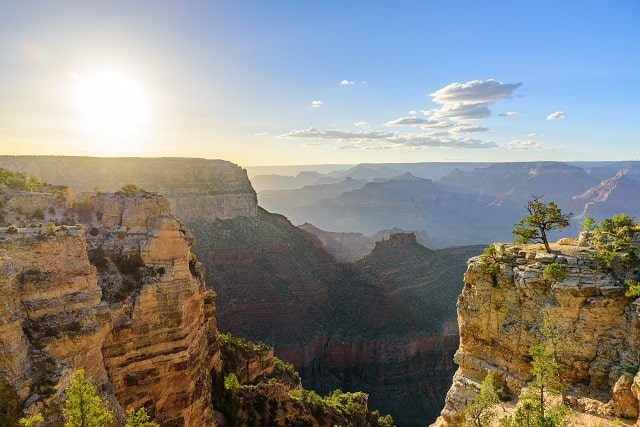
The temperature both at the canyon and deep inside the canyon is ideal. Summer is still a month or two away; therefore, the weather isn’t too hot and can sometimes even still see hints of winter temperatures.
During the month of April, the north rim still remains closed to the public only leaving the more popular south rim open for visitors year-round.
April is ideal for tourism if wanting to experience the canyon with summer weather but also want to avoid the summer crowds.
Although, it is recommended to avoid visiting the canyon in early April due to the large spring break crowds.
Once the first week is over the canyon appears to be far less crowded. Thus, making it a great time to visit as you’ll be able to experience the tranquillity that the canyons have to offer along with the warm weather.
Minor inconveniences when visiting the Grand Canyon during the spring months include the remaining potential of winter and snowstorms. Although, if this was to happen it would only be a small amount of snow and wouldn’t likely affect your trip unless you were hoping for warm sunny weather.
Other issues include the north rim is closed – although, the south rim remains open and offers many fantastic hikes, lookouts and experiences.
Additionally, large crowds generally happen in early April because of spring break. This is for the most part, avoidable by simply planning your trip after the spring break crowds have dispersed following the first week.
Thank you for supporting this website written by an American. This post may contain affiliate links. This means I earn a small commission on these links at no extra cost to you.
To visit any of the National Parks in the USA, I recommend buying a National Park Pass. The America the Beautiful Pass is valid for one year and costs $80. Plus 10% of sale proceeds go to the National Park Foundation.
Is the Grand Canyon open in April?
The Grand Canyon National Park remains open every day for year-round visitors.
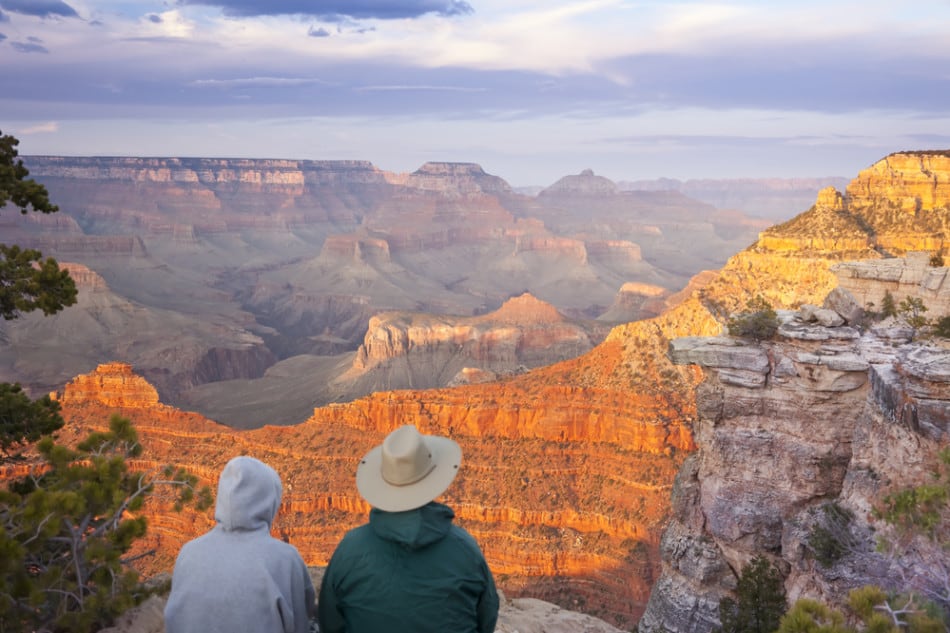
Yes, the Grand Canyon is open in April. During this month, visitors can explore the South Rim, which is accessible year-round. However, it’s important to note that the North Rim typically remains closed in April due to weather conditions and usually opens around May 15. April is a fantastic time to visit the South Rim, offering pleasant weather and the opportunity to experience the park’s beauty with fewer crowds compared to the peak summer months.
The South Rim is open year round and there are many beautiful Grand Canyon Lookout Points. Grand Canyon South Rim in April is a pleasant time to visit the Grand Canyon.
How busy is the Grand Canyon in April?
The Grand Canyon in April is moderately busy. It’s a popular time due to the pleasant weather and the natural beauty of the canyon during spring.
However, the crowds are generally less dense compared to the peak summer months. Early April can be busier due to spring break, with more families and student groups visiting.
If your visit coincides with Easter, which sometimes falls in April, expect a slight increase in visitors around that holiday.
The more popular South Rim, open year-round, tends to attract more visitors, but it’s still less crowded than in summer.
The North Rim remains closed in April, which also influences overall visitor numbers. For a more tranquil experience, consider visiting after the first week of April, when spring break crowds have typically dispersed.
The more popular South Rim remains open year-round but the North Rim does not open until May 15th. You can read more about the South Rim vs the North Rim on my site.
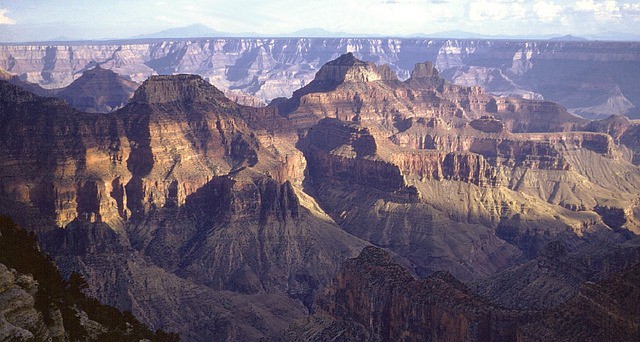
Is it a good time to visit Grand Canyon in Spring?
There is never a bad time to visit the Grand Canyon.
Visiting the Grand Canyon in spring, particularly in April, is indeed a great time for several reasons:
- Pleasant Weather: Spring brings milder temperatures, making it ideal for outdoor activities like hiking and sightseeing. The weather is warm enough to be comfortable during the day, yet not as hot as in the peak summer months.
- Fewer Crowds: While early April might see a spike in visitors due to spring break, the rest of the spring season generally experiences fewer tourists compared to summer. This means more space and tranquility for you to enjoy the views and trails.
- Natural Beauty: Spring is a time of renewal, and the Grand Canyon is no exception. You can enjoy the blooming of wildflowers and the vibrant colors of the canyon walls enhanced by the softer spring light.
- Wildlife Viewing: Spring is an excellent time for wildlife spotting, as many animals are more active during the cooler parts of the day.
- Hiking Conditions: The cooler temperatures make for more comfortable hiking conditions, especially for longer trails that might be challenging in the summer heat.
Spring in the Grand Canyon is a great time to visit with less crowds, clear skies and cooler weather. I think the key to visiting in the winter is to have good shoes. You cannot just wear sneakers as the snow will melt and get in your shoes. Waterproof shoes are a must!
What is the weather in Grand Canyon in April?
Grand Canyon weather in April is incredible. Its very pleasant during the day without it getting too hot.
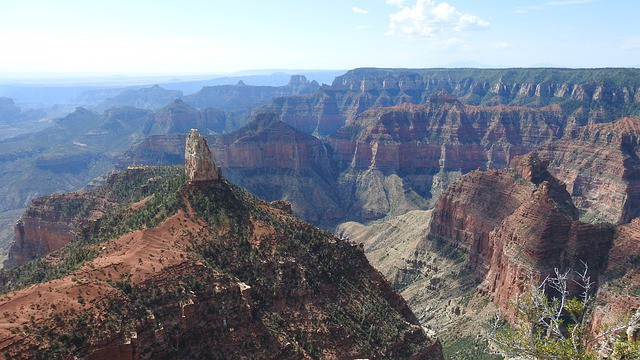
The weather in the Grand Canyon during April is generally pleasant, making it a great time to visit. Here’s what you can expect:
- Daytime Temperatures: On average, daytime temperatures in April at the Grand Canyon range from the mid-50s to low 60s degrees Fahrenheit (around 13 to 17 degrees Celsius). This means you can enjoy outdoor activities comfortably without the intense summer heat.
- Nighttime Temperatures: In the evenings and at night, temperatures can drop significantly. The average nighttime temperature hovers around the mid-20s to low 30s degrees Fahrenheit (approximately -4 to 1 degree Celsius). It’s important to be prepared for cooler nights, especially if you plan to stay out late or camp.
- Precipitation: April is relatively dry at the Grand Canyon, but there is still a chance of occasional rain showers. It’s a good idea to bring a light rain jacket just in case.
- Snow: While snow is less common in April, there is still a possibility of snowfall, particularly at higher elevations. However, any snow that does fall is usually minimal and unlikely to disrupt your trip.
- Daylight Hours: April days are getting longer, providing more daylight hours for exploration and outdoor activities.
Overall, April offers pleasant daytime temperatures for hiking and sightseeing, but it’s important to be prepared for cooler nights. Checking the weather forecast before your trip and dressing in layers will ensure you have a comfortable experience at the Grand Canyon during this time of year.
What to Wear to the Grand Canyon in April?
When visiting the Grand Canyon in April, it’s essential to be prepared for varying weather conditions. Here’s what to wear:
- Layers: Dress in layers for the fluctuating temperatures. Start with a moisture-wicking base layer, add a warm insulating layer, and top it with a waterproof and windproof outer layer.
- Comfortable Clothing: Wear comfortable, breathable clothing for hiking and outdoor activities. Opt for long pants and a long-sleeve shirt to protect against sunburn and potential cool evenings.
- Sturdy Footwear: Choose comfortable, supportive hiking boots or sturdy walking shoes with good traction. Ensure they are broken in before your trip to prevent blisters.
- Headwear: Bring a wide-brimmed hat or a cap to shield your face from the sun. Sunglasses with UV protection are also essential.
- Sunscreen: Apply sunscreen with a high SPF rating to protect against the strong sun at higher elevations.
- Rain Gear: Pack a lightweight, waterproof jacket or poncho for unexpected rain showers.
- Warm Layers for Evenings: Since evenings can be chilly, pack a warm fleece or jacket to stay comfortable after sunset.
- Backpack: Carry a small backpack to store essentials like water, snacks, a first-aid kit, and extra clothing layers.
- Water and Hydration: Stay hydrated by bringing a refillable water bottle. Water sources in the park may be limited.
- Optional Accessories: Consider bringing gloves, a buff or scarf, and hiking poles for added comfort and safety.
Is the Grand Canyon cold in April?
Yes, it can get cold in the Grand Canyon in April but it is a fantastic month to visit. January and February are the coldest months and it is starting to get warmer in April. During the day it is on average 61 degrees but at night it averages 26 degrees.
Did you know that it is actually much warmer in the Canyon? If you walk down into the Canyon or stay at Phantom Ranch, it averages 82 during the day.
April Adventures: What to do at the Grand Canyon in April
Visit the Visitors Centre to find out the conditions
Begin your Grand Canyon experience at the South Rim Visitor Center, a crucial first stop to gather essential insights for your visit.
Open from 8 am to 5 pm, this center is a hub of current information and expert advice. As a seasoned visitor, I’ve learned the value of tapping into the rangers’ extensive knowledge.
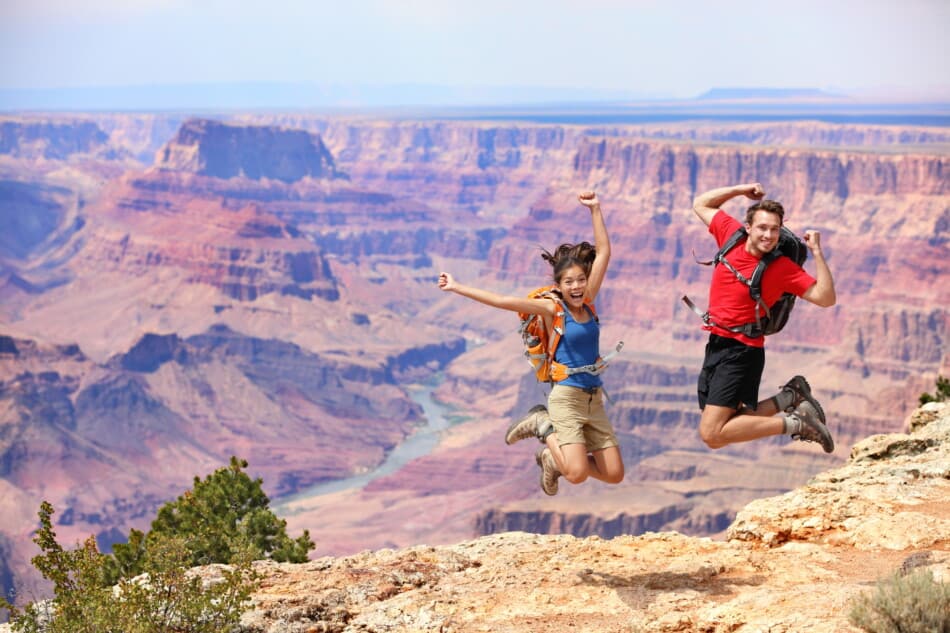
They’re not just guides; they’re guardians of the canyon’s secrets, offering updates on weather, trail conditions, and lesser-known scenic spots that could easily be missed.
Their expertise is especially vital for navigating the dynamic weather patterns of the canyon. On my last visit, a ranger’s suggestion led me to a breathtaking, secluded viewpoint, away from the usual tourist paths. It’s these hidden treasures that can transform a good trip into an unforgettable adventure.
Moreover, the center also hosts a captivating 20-minute film that provides a comprehensive introduction to the park’s geological history, flora, and fauna. This film, coupled with the detailed maps and brochures available, allows you to plan your visit more effectively.
From personal experience, these resources are invaluable in maximizing your time at the canyon, whether you’re keen on photography, hiking, or simply soaking in the views.
Remember, each visit to the Grand Canyon is unique. The visitor center, with its wealth of resources and knowledgeable staff, is your starting point to tailor an experience that resonates with your interests and expectations.
As a frequent explorer of this natural marvel, I assure you that a visit to the center enriches your understanding and appreciation of the Grand Canyon, setting the stage for a truly remarkable adventure.
See the sunrise at Mathers Point or Yavapai Point
After gearing up with insights from the Visitor Center, make your way to Mather Point, a must-see for any Grand Canyon visit.
Just a brief walk from the center, Mather Point offers one of the most spectacular sunrise views in the park.
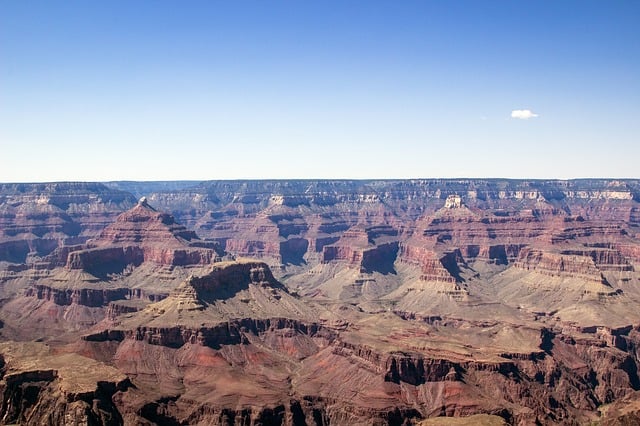
As someone who’s witnessed this natural wonder multiple times, I suggest arriving early to secure a prime viewing spot. The early morning light paints the canyon walls in hues of gold and amber, a sight that’s both humbling and exhilarating.
The beauty of Mather Point lies not just in its panoramic views, but also in its accessibility. The large viewing platform accommodates many visitors, but its popularity means it can get crowded.
From personal experience, the tranquility of dawn at this spot, before the crowds arrive, is unparalleled. It’s a perfect time for photographers and nature lovers alike to capture the canyon’s grandeur in peace.
My own memorable moment here was watching a majestic eagle soar over the canyon as the sun rose, a reminder of the park’s thriving ecosystem. Such encounters add an extra layer of wonder to the already stunning scenery.
Remember, while Mather Point is a renowned spot, it’s just the beginning of what the Grand Canyon has to offer. Each lookout point along the rim provides a unique perspective of this vast geological masterpiece.
As you explore further, you’ll find that the Grand Canyon is not just a single view, but a series of ever-changing landscapes, each with its own story and beauty.
Yavapai Point is another great place for many tourists and visitors to see the sunrise.
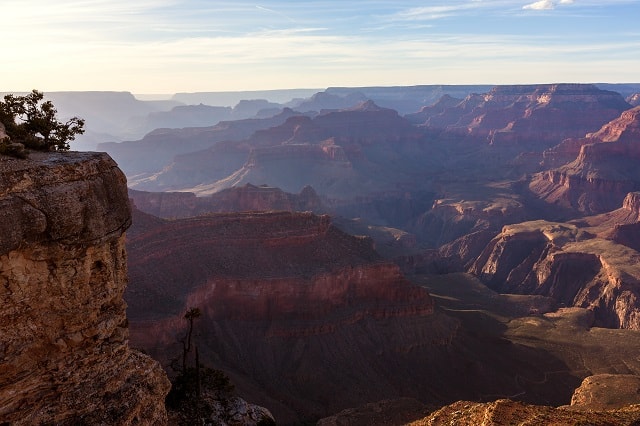
Unlike Mathers Point, Yavapai Point generally is not as crowded for sunrise, making it a bit more appealing to those who want a peaceful, tranquil experience while viewing the sunrise. The sunrise here is a must-see when visiting this national park due to the stunning panoramic views the spot offers of the sun rising through the canyons.
Hike down to Plateau Point for fantastic views of the inner canyon
Moving from the majestic sunrise at Mather Point, the Plateau Point Trail presents an invigorating challenge for those who seek to delve deeper into the Grand Canyon’s heart.
This 12-mile round trip, starting at the Bright Angel Trailhead, isn’t just a hike; it’s an expedition into the canyon’s soul. As a seasoned hiker who has traversed this trail, I can attest to its rigorous yet rewarding nature.
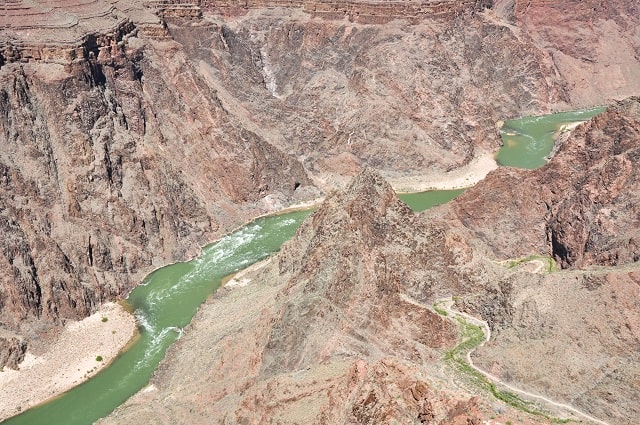
The journey begins with a descent, winding through layers of geological history, each step a testament to the canyon’s ancient past.
Along the way, the trail offers a kaleidoscope of breathtaking vistas, from towering cliffs to the vibrant hues of the canyon walls at different times of the day. The changing light plays with the colors, creating a dynamic visual feast.
Reaching Plateau Point, you’re greeted with awe-inspiring views of the inner canyon. It’s a vantage point few get to see, offering a panoramic spectacle of the Colorado River’s serpentine path below.
The tranquility here is profound – a stark contrast to the often-busy rim viewpoints. It’s a place where you can sit, reflect, and absorb the grandeur of nature uninterrupted.
Preparation is key for this hike. Start before sunrise to avoid the midday heat and ensure you have enough daylight.
Equipping yourself with plenty of water, snacks, and comfortable hiking gear is crucial. Remember, this trail is as challenging as it is beautiful, demanding respect for both its physical demands and natural wonders.
Each rest stop along the way is an opportunity not just to catch your breath, but to truly appreciate the canyon’s ever-changing landscape.
In my experiences, the Plateau Point Trail has always been a journey of discovery, offering not just spectacular views, but also a deeper connection with the natural world. For those willing to take on the challenge, it promises an unforgettable adventure in one of the world’s most iconic landscapes.
Desert View Drive
After the exhilarating hike to Plateau Point, take a scenic drive along the Desert View Drive, a 25-mile stretch offering some of the Grand Canyon’s most magnificent views.
Having driven this route numerous times, I can vouch for its unique beauty and the variety of vistas it offers. Starting just one mile west of the Grand Canyon Village, this drive is a journey through different perspectives of the canyon.
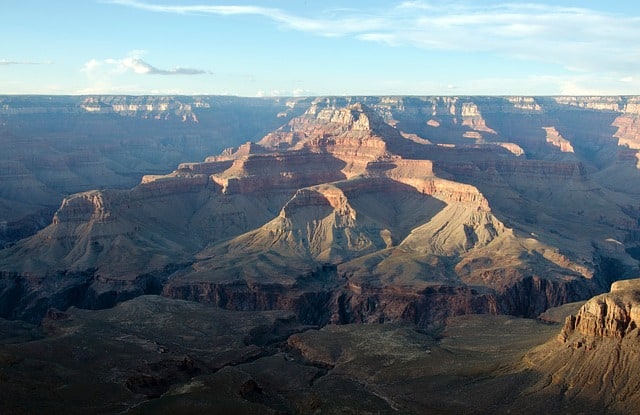
One of my personal favorite stops along this route is Yaki Point. Inaccessible by private vehicle, it’s a serene spot reachable by the park’s free shuttle bus. The panoramic views here, especially at sunrise or sunset, are nothing short of spectacular, offering a quieter alternative to the more frequented viewpoints.
Another must-see is the whimsically named Duck on a Rock viewpoint. Located just east of Yaki Point, it’s easy to miss but worth the effort. This spot offers a unique rock formation that resembles a duck perched atop a rock, showcasing the whimsical side of nature’s artistry.
Each stop along Desert View Drive presents a unique story and view of the canyon. From my experiences, I recommend taking your time to stop at as many points as possible. Each offers a different angle, a different light, and a unique memory. Whether it’s your first visit or your tenth, the Desert View Drive never ceases to amaze with its breathtaking views and serene moments, making it an essential part of any Grand Canyon adventure.
Rim Trail from Visitor Centre to Village.
The Rim Trail offers a more relaxed yet equally rewarding experience. Stretching from the Visitor Center to the Grand Canyon Village, this 2.5-mile paved path is perfect for those who prefer an easy yet scenic walk.
As someone who has strolled this trail many times, I can assure you it’s packed with stunning viewpoints and quieter spots to enjoy the grandeur of the canyon.

The beauty of the Rim Trail lies in its accessibility and the ease with which it offers some of the best views of the canyon.
The trail is mostly flat and well-maintained, making it suitable for visitors of all ages and fitness levels. Along the way, you’ll encounter several outstanding overlooks, each providing a unique perspective of the vast landscape.
One of my favorite aspects of this trail is its flexibility. You can hop on and off at various points, making it perfect for a leisurely day of exploration.
There are plenty of benches to rest, and the trail is lined with informative plaques that offer insights into the canyon’s geology and history.
Whether you’re looking for a place to reflect quietly or capture the perfect sunset photo, the Rim Trail is a must-do. It’s a gentle journey along the edge of one of the world’s most magnificent natural wonders, offering moments of peace and awe-inspiring views that linger in your memory long after the walk is over.
This is perfect for those who want to experience the beauty of the canyons without exerting themselves too much by hiking through the canyons.
This trail is considered to be generally easy by those who have completed it and is a great way to spend a warm sunny day.
Tusayan Museum and Ruin
The Tusayan Museum and Ruin, located just 3 miles west of Desert View Drive, is a portal to the Grand Canyon’s ancient past. This site, which I’ve visited several times, offers a fascinating glimpse into the lives of the ancestral Puebloan people who inhabited the area over 800 years ago.

At the museum, you’ll find exhibits that showcase artifacts and tell the story of these early inhabitants.
It’s a journey through time that highlights their daily lives, cultural practices, and the remarkable ways they thrived in this challenging environment. For me, each visit has been an eye-opening experience, deepening my appreciation for the canyon’s rich human history.
Stepping outside, the adjacent ruin is a must-see. Walking among the remnants of the Pueblo Village, you can’t help but feel a connection to the past.
The site is well-preserved, allowing you to clearly envision the community that once thrived here. Informational plaques provide context, making it an educational experience as well as a reflective one.
Visiting the Tusayan Museum and Ruin adds a profound layer to your Grand Canyon visit. It’s not just about the natural beauty; it’s also about understanding and respecting the people who have called this place home for thousands of years. It’s a reminder that the Grand Canyon’s story is as much human as it is geological.
Many historians have estimated that human civilization has been in the area of the Grand Canyon for around 12,000 years. Therefore, there are many archaeological remains in the area to be discovered and protect.
The Tusayan Museum is designed to teach visitors about the long history and all the previous unique civilizations that lived in the area. The ruins itself contains remains of the Pueblo Village that is believed to be upwards of 800-years old.
See a film at the IMAX in Tusayan
A unique and immersive experience awaits at the IMAX theater in Tusayan, just outside the South Rim entrance.
As someone who’s been captivated by the film shown here, “Grand Canyon: The Hidden Secrets,” I highly recommend it as part of your Grand Canyon visit.
This 30-minute film is not just a movie; it’s an adventure that takes you through the canyons, over the river, and into the heart of the Grand Canyon.
The large screen and state-of-the-art sound system make it feel like you’re soaring over the landscape, diving into the history and natural wonders of this incredible place. The film runs every hour on the half-hour, making it easy to fit into your schedule.
The theater itself, with comfortable seating and air-conditioning, offers a welcome respite from the outdoor elements. It’s a perfect way to either start your visit, setting the stage for what you’re about to see, or conclude it, reflecting on the majesty you’ve just experienced.
As someone who’s seen the film several times, I find it offers new insights with each viewing. It’s a testament to the enduring allure of the Grand Canyon, revealing aspects you might miss during a typical visit.
For both first-time visitors and seasoned explorers, the IMAX experience at Tusayan is a memorable addition to your Grand
See the sunset at Pima Point
Pima Point offers a remarkable sunset view and is a must-visit along the Hermit Road. This point, which I’ve frequented for its serene beauty, is the last stop before reaching Hermit’s Rest, offering a wide, panoramic view of over 40 miles of the Grand Canyon.
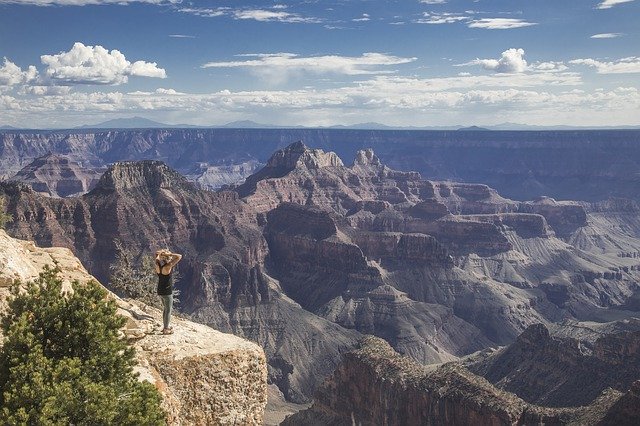
The magic of Pima Point lies in its relatively uncrowded environment, providing a peaceful setting to watch the sunset. The sun dipping below the horizon, casting vibrant colors across the sky and canyon walls, is an unforgettable sight. During my visits, I’ve found arriving a bit early helps secure a great spot, free from distractions.
One important note: In April, Hermit Road is closed to private vehicles, so accessing Pima Point requires using the free shuttle buses or hiking. This makes the spot more exclusive and less crowded compared to other viewpoints.
The tranquility and expansive views at Pima Point make it one of my favorite spots for reflecting on the day’s adventures. Whether you’re capturing the moment through a lens or simply soaking it in, the sunset here is a perfect capstone to a day at the Grand Canyon, offering a quiet moment to appreciate the park’s grandeur.
Grand Canyon Skywalk
The skywalk is located along the west-rim of the Grand Canyon and consists of a horse-shoe glass bridge extending 70-feet over the rim of the canyon.
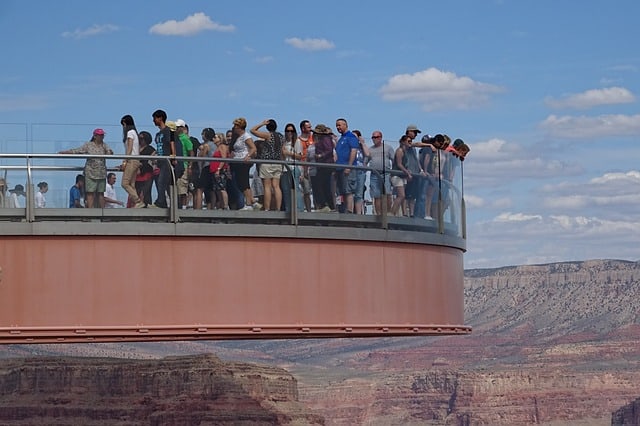
The bridge itself is made from glass, so if you look down you can see over 4,000 feet below to the canyon grounds. This is truly a unique experience and offers views of the canyons that you can’t get anywhere else!
There is also a gift shop and a restaurant located at the bridge to make your experience even longer and better.
Helicopter Tour over the Canyon
What better way to see the beauty of the canyons and all it has to offer than seeing it from a helicopter flying above?!
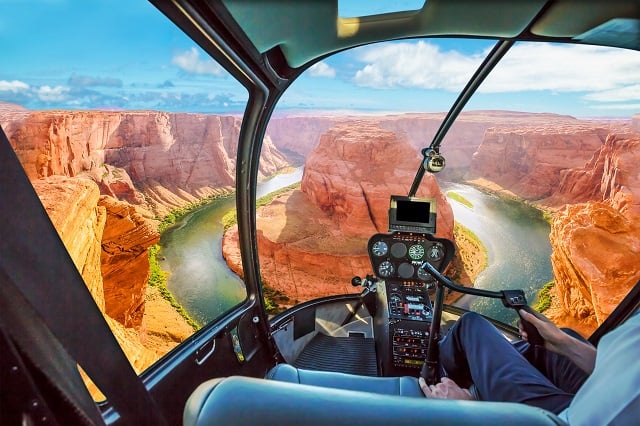
Helicopter rides over the canyon give visitors a unique experience and provide views that otherwise would be missed. By doing a helicopter tour, visitors get to experience the canyons by looking down into them, something that is often missed when just looking out from a viewpoint.
Although these tours are often a bit pricey, they are well worth it and will provide unforgettable memories.
Where to stay near the Grand Canyon
Tusayan is the nearest city to the Grand Canyon. The population city of Tusayan is only 550. The city is located along Highway 180 about 70 miles from Flagstaff.
You will find shops and restaurants there, the Grand Canyon IMAX, and the Grand Canyon Airport is about one mile south of town.
Another benefit of going in the Spring with less tourists is the fact that booking accommodation will be easy! I don’t recommend just showing up though because some places will be closed.
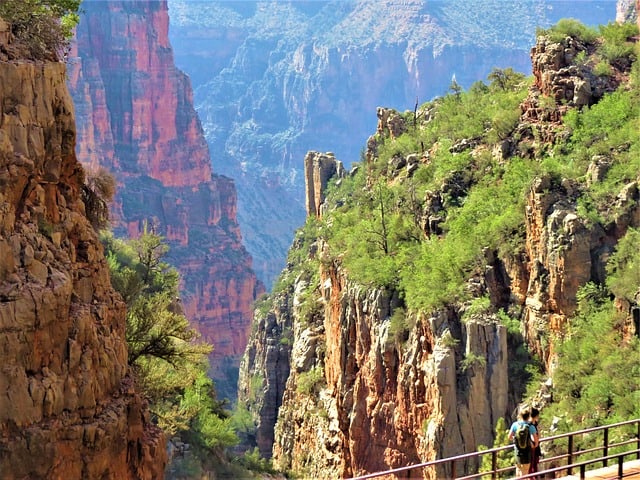
Canyon Plaza Premier Studio and Apartments
Views of the valleys and forest areas are featured in select Arizona apartments. Grand Canyon South Rim Entrance is 5 minutes’ drive.
Studios feature a kitchenette and apartments offer a fully equipped kitchen at Canyon Plaza Premier Studio and Apartments. A balcony is provided in each unit.
JJK’s Restaurant is open for breakfast, lunch, and dinner at the Studio and Apartments Canyon Plaza Premier.
Arizona Luxury Expeditions – Grand Canyon
Arizona Luxury Expeditions has tents where you can glamp overnight. This is part of their ll inclusive and customized to include 12’x12′ Expedition Tents, all meals freshly prepared daily, and a professional Tour Guide for your stay with us.
The weather at the Grand Canyon during Dec. averages 30-40 degrees Fahrenheit daytime and 20’s degree at nighttime. They provide heaters for inside your sleeping and the private dining tents with plenty of warm heavy wool blankets. Most guests enjoy this time of the year in the Grand Canyon because of less crowds of people and the winter landscape that is incredible to experience.
Best Western Premier Grand Canyon Squire Inn
Located right next to the Holiday Inn Express, the Best Western has 250 rooms. The Best Western has an indoor heated pool, a hot tub, sauna, and fitness center.
There is also two restaurants in the hotel – Coronado Room and the Canyon Room. If you are looking for fast food you can find the McDonalds and Pizza Hut are close.
Holiday Inn Express Grand Canyon
The Holiday Inn Express is located just two miles from the South Entrance of the Grand Canyon. The Holiday Inn Express has 164 rooms and is located centrally in Tusayan which means you can walk to the restaurants and shops.
The Holiday Inn Express has an indoor pool, a whirlpool, and a continental breakfast is included.
The Grand Hotel at the Grand Canyon
The hotel offers 5-star accommodation with a hot tub. All units are equipped with air conditioning, a flat-screen TV with satellite channels, a microwave, a coffee machine, a shower, a hairdryer and a desk. Guest rooms include a wardrobe.
Featuring a restaurant, bar, shared lounge and free WiFi, The Grand Hotel at the Grand Canyon is located in Tusayan, 10 km from Mather Campground and 12 km from Bright Angel Trail. This 5-star hotel offers a concierge service and a tour desk. The hotel features an indoor pool, fitness centre, evening entertainment and a 24-hour front desk.
Grand Canyon Plaza Hotel
Canyon Plaza Premier Studio and Apartments is a 3 star hotel located 6 miles from the Grand Canyon.
There are only 10 rooms here and each room has a microwave, a refrigerator, and a coffee maker.
There is one restaurant here called JJK’s restaurant. Close to the hotel is the Plaza Bonita where you can also eat.
Conclusion – Is it worth visiting the Grand Canyon in April?
The warm weather, the minimal tourism, the unique activities and the beautiful canyons all make for April a great time to visit the Grand Canyon! Being able to hike through the canyons in warm sunny weather without having the summer crowds makes it ideal for those wanting a tranquil experience. The unique experiences offered during this time also make April a perfect time for those wanting to visit the Grand Canyon!
Over to you! Have you visited the Grand Canyon in April? How did you like it? Let me know in the comments below about your experience at the Grand Canyon.
Continue Reading More on my website:
Best Hiking Trails in the Grand Canyon
Visiting the Grand Canyon in March
Visiting the Grand Canyon in February
Visiting the Grand Canyon in January
Visiting the Grand Canyon in December
Recent Posts
Discover the Top 19 Unforgettable Day Trips Just Hours from Vegas! Are you looking for day trips from Vegas? Whether you are looking to get away from the strip or are using Vegas as a base...
Vegas Fine Dining: A Tour of 15 Exquisite Upscale Dining Destinations Welcome to the ultimate guide to upscale dining in Las Vegas! Whether you're a seasoned foodie or simply seeking a taste of...
